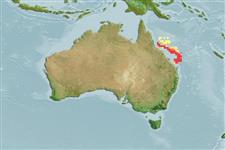Пластиножаберные (акулы и скаты) (sharks and rays) >
Torpediniformes (Electric rays) >
Narcinidae (Numbfishes)
Etymology: nelsoni: Named after Gareth Jon Nelson, who was my PhD advisor at the American Museum of Natural History (New York), in honor of his very unique and meaningful contributions to both ichthyology and comparative biology in general.
Eponymy: Dr Gareth (Gary) Jon Nelson (d: 1937) is Emeritus Curator Vertebrate Zoology, Ichthyology, at the AMNH where he worked for over three decades (1967–1998), having been chairman of ichthyology (1982–1987) and of ichthyology and herpetology (1987–1993) [...] (Ref. 128868), visit book page.
Environment: milieu / climate zone / depth range / distribution range
экология
морской донно-пелагический; пределы глубины 140 - 540 m (Ref. 76955). Tropical; 16°S - 24°S, 147°E - 155°E (Ref. 114953)
Southwest Pacific: eastern Australia, probably more widespread in the Coral Sea
Length at first maturity / Size / Вес / Возраст
Maturity: Lm ?, range 19 - ? cm
Max length : 31.3 cm TL самец/пол неопределен; (Ref. 76955); 34.8 cm TL (female)
Maturity size reaches ca. 26 cm TL; born at ca. 8 cm TL. Biology little known (Ref. 114953).
Life cycle and mating behavior
половая зрелость | размножение | нерест | икра | Fecundity | личинки
Last, P.R., W.T. White, M.R. de Carvalho, B. Séret, M.F.W. Stehmann and G.J.P. Naylor, 2016. Rays of the world. CSIRO Publishing, Comstock Publishing Associates. i-ix + 1-790. (Ref. 114953)
Статус Красного Списка МСОП (Ref. 130435: Version 2024-1)
Угроза для людей
Harmless
Использование человеком
дополнительная информация
инструменты
Специальные отчеты
Скачать в формате XML
ресурсы в Интернет
Estimates based on models
Preferred temperature (Ref.
123201): 15.6 - 21.4, mean 18.8 °C (based on 21 cells).
Phylogenetic diversity index (Ref.
82804): PD
50 = 0.5312 [Uniqueness, from 0.5 = low to 2.0 = high].
Bayesian length-weight: a=0.01175 (0.00470 - 0.02937), b=2.88 (2.66 - 3.10), in cm total length, based on LWR estimates for this (Sub)family-body shape (Ref.
93245).
Trophic level (Ref.
69278): 3.3 ±0.4 se; based on size and trophs of closest relatives
Fishing Vulnerability (Ref.
59153): Low vulnerability (25 of 100).
